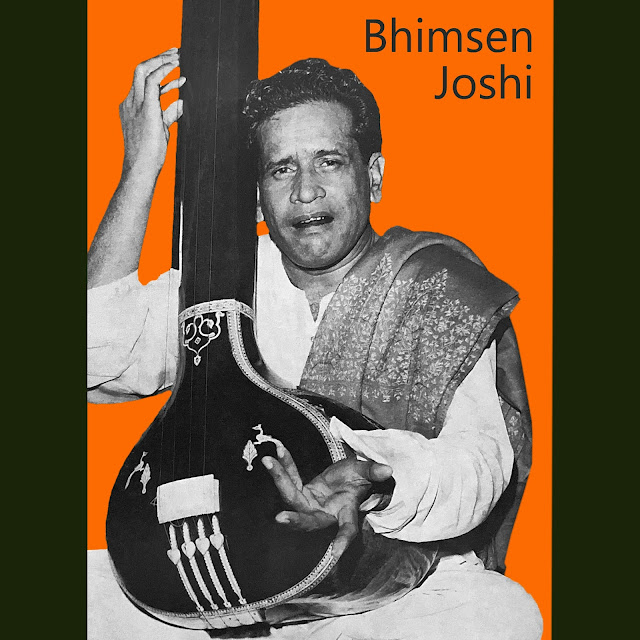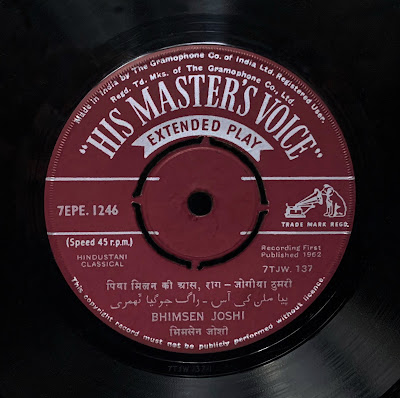INDIA – INDE
Bhimsen Joshi – Raga Miyan Ki Todi and Raga Jogiya Thumri – His Master's Voice – 7 EPE 1246, released 1962 (7 in, 45 RPM)
Bimsen Joshi (1922-2011) was among the greatest and most popular Hindustani Kyal singers of the second half of the 20th century. Though he did not come from a musical family, from a young age he felt such an intense passion for singing that he left his home in Karnakata at the age of 11 for two years in search of a guru in Northern India notably in Gwalior, where he met singer Krishnarao Shankar Pandit (1894–1989) and sarod master Hafiz Ali Kahn (1888–1972) and began a stringent 12-hour-a-day musical training. Returning home he was accepted by Sawai Gandharva (1886-1952) – the most famous disciple of the founder of Kirana Gharana Abdul Karim Khan (1872-1937) – as his disciple, in 1935.
The brilliant student began performing and recording shellac 78 RPMs in the early 1940s, crafting a unique singing style influenced by great singers like Begum Akhtar (1914-1974), Kesarbai Kerkar (1892-1977) and Amir Khan (1912-1974). Steeped in the time-honored tradition, Joshi also embodied a changing modern India, playing music that transcended class, caste and religion, by singing bhajan and abhang devotional songs in Kannada, Hindi and Marathi languages which brought him a large nationwide audience.
Bimsen Joshi (1922-2011) fût l'un des chanteurs Hindustani de Kyal les plus populaires de la seconde moitié du XXe siècle. Bien que n’étant pas issu d’une famille de musiciens, il éprouve une passion dévorante pour le chant dès son plus jeune âge et quitte même le foyer familial à Karnakata seul à l’âge de 11 ans pendant deux années à la recherche d’un gourou en Inde du nord, notamment à Gwalior, où il rencontre le chanteur Krishnarao Shankar Pandit (1894-1989) et le maître du sarod Hafiz Ali Kahn (1888-1972). C’est là qu’il s’adonne corps et âme à la musique pendant plus de 12 heures par jour. De retour chez lui, Sawai Gandharva (1886-1952) – le plus célèbre disciple du fondateur de l’école Kirana Gharana Abdul Karim Khan (1872-1937) – l’accepte comme son disciple en 1935.
Le brillant élève commence à se produire en public et à enregistrer des 78 tours à partir du début des années 1940, forgeant un style de chant unique inspiré par des grandes figures comme Begum Akhtar (1914-1974), Kesarbai Kerkar (1892-1977) et Amir Khan (1912-1974). Profondément ancré dans la tradition, Joshi incarnait également une Inde moderne en mutation. Il propose ainsi une musique qui transcende les classes sociales, les castes et les religions, avec notamment des chants bhajans et abhang dévotionnels en kannada, en hindi et en marathi, ce qui lui valut une très grande renommée dans l'ensemble du pays.
Bhimsen Joshi – HMV – ECLP 2264 here
Hirabai Barodekar and Saraswati Rane – ECLP 2356 here
Please help me
purchase
important traditional records to pursue my global




Teşekkürler...
ReplyDeletewow
ReplyDeleteThank you!
ReplyDelete